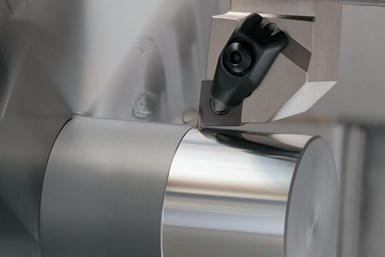Kyocera Turning Inserts Provide Fracture, Wear Resistance
The KBN010 high-speed CBN grade gives users more flexibility, range, performance and tool life when turning hardened materials.
Kyocera Precision Tools’ KBN010 high-speed CBN grade is designed to give manufacturers a larger range of hard turning capabilities.
Specialized for high-speed finishing, the mixed structure of micro-grain and coarse-grain CBN provides greater wear resistance and optimal surface finish at higher speeds.
Using new layering techniques, Kyocera has developed the Megacoat Tough coating technology, which combines a highly wear-resistant layer on the surface adhered to high-content CBN used to toughen up the edge. This provides greater fracture resistance when encountering interruptions. The adhesion layer is laminated between the wear-resistance layer and the CBN to reduce layer peeling for longer tool life and stable machining. The tools provide wear resistance and fracture resistance to give the user more flexibility, range, performance and tool life when turning hardened materials.
KBN020 supports a wide range of hardened applications from continuous to heavily interrupted machining. The product range features a full lineup of negative and positive insert geometries, a variety of edge preps and multiple cutting edges per insert. Recommended applications include hardened materials (55 HRc or more) and external and internal turning, facing and boring.
Related Content
-
Data Matrix Codes Offer Cutting Tool Traceability
A company’s quest to discover errors in a manufacturing process has led to printing data matrix codes on its cutting tools that provide a wealth of information for both the user and this cutting tool manufacturer.
-
Tool Path Improves Chip Management for Swiss-Type Lathes
This simple change to a Swiss-type turning machine’s tool path can dramatically improve its ability to manage chips.
-
Parting Off: The Case for Standardizing on Sawing
The value of rotary saw cutting for parting off operations could boil down to simple economics paired with process efficiency gains.
.png;maxWidth=970;quality=90)







.png;maxWidth=300;quality=90)





.png;maxWidth=970;quality=90)